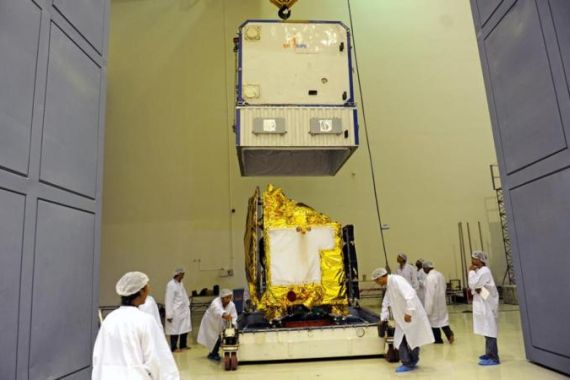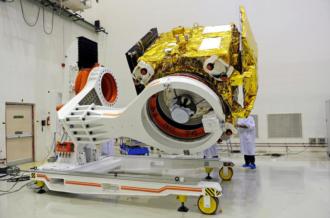India aims high with Mars mission
Tuesday’s launch of the Mars orbiter mission is primarily aimed at testing the country’s space technology.

Sriharikota, India – India’s first ever mission to Mars promises some sci-fi thriller moments.
Soon after the lift-off at 14:38 on November 5, the blip representing the spacecraft’s trajectory will go off the screen for a little over 10 minutes.
Indian Space Research Organisation (ISRO) scientists at the master control room, located at the Satish Dhawan Space Centre in Sriharikota, will be driving blind for that small duration. That is when the launch vehicle PSLV-C25 will go out of range from all the ground stations tracking it.
When the blip comes back on screen, the tracking signals will be coming from one of the two ships fitted with special antennae positioned somewhere in the South Pacific Ocean.
Those two ships, deployed to track the satellite’s orbit, represent just one of the many innovations of the country’s first Mars orbiter mission. Innovations and improvisations have helped ISRO put together a spacecraft fitted with five instruments to orbit Mars at a cost of $70m.
“This is less than one-tenth of what the US has spent on their Mars mission Maven,” says S. Arunan, the mission’s project director, while interacting with reporters at a pre-launch press conference last week. The cost-effectiveness of the mission is indeed turning out to be the highlight of the project, almost eclipsing the other aspects.
The orbiter will have to undergo some 300 days of complex manoeuvring before it reaches the Martian orbit. After accomplishing that, the satellite is expected to be in orbit for scientific exploration “for a few months, if all goes according to plan”, according to ISRO Chairman K Radhakrishnan.
The satellite will carry out atmospheric, particle environment and surface imaging studies of Mars, according to ISRO. One of the satellite’s projects will be to look for the presence of methane. “This should give a clue regarding biological or geological phenomenon on Mars,” says Radhakrishnan.
Joining elite club
If all goes according to plan, the interplanetary expedition will place India in an elite club of countries. The Soviet Union first attempted a mission to the Red Planet in 1960. The United States started its Mars exploration programme with a launch in 1964, while Japan launched its first spacecraft to Mars in 1998. The European Space Agency’s Mars Express was launched in 2003, and China was the most recent country to attempt a Mars mission, in 2011.
Radhakrishnan says there are huge challenges in communicating with satellites that are travelling at least 400 million kilometres away from Earth. Even so, he says, the mission will be “a great learning for the country. And once we have learnt, we can look at larger missions in 2016, 2018 and 2020,” referring to the subsequent years when Mars will be orbiting closest to earth.
“We are not in a race with anybody,” the ISRO chairman added. In recent years, Japan and China have taken the space race to a different level, with China launching an “anti-satellite test” in 2007, making it the third country to have done so. In comparison, neighbouring India’s missions seem modest.
“Not just in counter-space technology, India is much behind China in the number of space missions undertaken and more importantly in development of indigenous space technology,” says Dr V Ponraj, the scientific adviser to India’s former President Dr Abdul Kalam.
 |
| India will join an elite club of nations with its Mars mission [Indian Space Research Organisation] |
While India has launched just over 100 missions in the last 37 years, China has launched more than 80 missions since 2006, says Ponraj.
The relevance of India’s space mission among the top contenders in space like US, Europe, Russia, Japan and China, is in its economic viability. And in that respect the Mars Orbiter Mission fits the bill perfectly.
The underlying message to the international space community is that the country can put technology in space at an extremely competitive price.
So far, ISRO has been focusing primarily on applications-related technology that are useful to common people.
The organisation’s commercial wing, Antrix Corporation, has been taking care of its business interests. Of the ISRO’s total budget, only seven to eight percent goes to scientific space exploration projects.
Chandrayan1 was India’s first unmanned lunar mission, launched in October 2008. The evidence sent back by Chandrayan 1 proved the presence of lunar water for the first time. Chandrayan1 signalled India’s interest in space exploration, and the Mars orbiter mission is the second project in line with that thinking.
However, these are still baby steps compared to projects like sending a manned mission to Mars.
Such a project would require that the vehicle should have a less than one percent chance of failure. But India’s Geosynchrnous Satellite Launch Vehicle (GSLV), which is most suited for such a mission, is nowhere near that reliability level. And ISRO says that India is a “good few years” from putting a human in space.
In those good few years, India hopes to get lucky with its planetary missions, and achieve what other international missions have not yet done.
The countdown has begun.